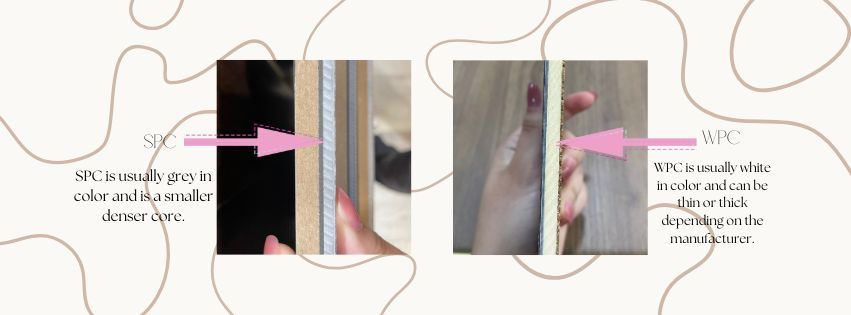Navigating the LVP Flooring Landscape: Understanding the Differences Between SPC and WPC for Homeowners and Designers
- Selina Rodriguez

- Nov 16, 2024
- 4 min read
Choosing the right flooring is often a challenging task for homeowners and interior designers alike. With a flood of options available, it becomes vital to distinguish between various types of flooring. One of the top choices currently trending is luxury vinyl plank (LVP), particularly two variations: Stone Plastic Composite (SPC) and Wood Plastic Composite (WPC). In this post, we'll break down these two flooring types, focusing on their construction, comfort, sound ratings, subfloor preparation, and overall quality.
Let’s get started!
What is LVP Flooring?
Luxury vinyl plank flooring is becoming more popular than ever. It beautifully mimics natural materials like wood and stone, giving your space an elegant look without the high cost. LVP is also known for its durability, making it a more practical flooring solution.
However, not all LVP is equal. Today, we’re highlighting SPC and WPC—two common subcategories of LVP that serve different needs and preferences.
Construction
SPC and WPC share a protective top layer that resists scratches, stains, and moisture, but their core constructions set them apart.
SPC Flooring:
SPC flooring comprises a core made from stone plastic composite—a mix of limestone powder and PVC. This construction results in a sturdy, waterproof floor, making it perfect for moisture-prone areas like kitchens and bathrooms. In fact, SPC can hold up under heavy foot traffic; it can endure impacts similar to those observed in many commercial environments.
WPC Flooring:
In contrast, WPC flooring features a core made from wood plastic composite, blending PVC with real wood elements. While WPC is also waterproof, it offers greater flexibility and comfort, perfect for residential spaces. Studies show that WPC can be an excellent option for areas like living rooms, where extended periods of standing or walking may occur without discomfort.

Comfort
Comfort underfoot is often a major factor in flooring selection. WPC flooring generally leads in this area thanks to its softer, cushioned feel, making it comfortable even during long periods of standing. Many homeowners who install WPC in their kitchens or playrooms appreciate the warmth it brings to their feet.
SPC flooring, however, is firmer due to its denser stone composite core. This sturdiness offers solid support but can feel uncomfortable if you're on your feet for long durations. For example, a study showed that people standing on SPC for more than four hours reported discomfort, while WPC users felt less strain.
Sound Rating
Sound absorption is essential for a quieter home or office environment.
SPC flooring lacks sound absorption due to its dense structure, it may not be as effective in decreasing noise levels in homes with high activity.
In comparison, WPC flooring excels in sound absorption thanks to its softer core. Its cushioned nature helps to minimize echoes, creating a quieter atmosphere that many residents of apartments or multi-level homes appreciate. In fact, users have reported up to a 20% reduction in noise transmission when comparing WPC to other flooring types.

Subfloor Preparation
Both SPC and WPC require less subfloor preparation than traditional hardwood or tile. However, there are slight differences to note:
SPC flooring requires meticulous subfloor preparation because of the core's rigidity, making it crucial for the subfloor to be nearly perfect. Any inadequacies in subfloor preparation can result in voiding the floor's warranty and potential cracks.
WPC, while also easy to install, does best with a more level subfloor to ensure optimal performance. However, homeowner reviews suggest WPC is still user-friendly for DIY installations, requiring minimal adjustments as the wood core allows more forgiveness.
Quality
When comparing overall quality, it's essential to consider the following:
SPC is recognized for its durability and longevity. Its sturdy core can handle heavy foot traffic, and heavy weight making it suitable for high-use areas and commercial settings.
WPC, while durable, is slightly less robust than SPC due to it having a softer core. However, its quality is commendable for residential use, especially for those who prefer a warmer, softer feel underfoot.
Pros and Cons
When deciding between SPC and WPC, consider these pros and cons:
SPC Pros:
Highly durable, suitable for heavy foot traffic.
Waterproof, ideal for moisture-prone areas.
Generally less expensive—costs can be around 20% less than WPC.
SPC Cons:
Firmer underfoot, which may feel uncomfortable over extended periods.
Limited sound absorption capabilities.
WPC Pros:
Comfortable and soft feel underfoot.
Superior sound absorption reduces noise, making it ideal for multi-level homes.
Aesthetic appeal closely matches real wood.
WPC Cons:
Slightly less durable than SPC in regard to heavy item placement.
Typically more expensive, with costs 15-30% higher than SPC.
Making the Right Choice
Choosing the right flooring involves understanding the unique characteristics of SPC and WPC.
SPC stands out for its durability and cost-effectiveness, while WPC offers comfort and superior sound insulation. Ultimately, your choice should be based on your specific needs, lifestyle, and aesthetic desires.
Before making your decision, consider the functionality of the spaces you are flooring and how each option aligns with your daily activities.
In this journey of choosing the ideal flooring for your home or project, I hope this breakdown of SPC and WPC LVP flooring helps clarify the options. If you need help selecting the perfect flooring for your forever home, let's chat! With the right flooring, you not only establish a foundation for your space, but you also create a canvas that reflects your style.

Happy flooring!
With this exploration of the LVP landscape, I hope you feel better prepared to select flooring that meets your needs as a homeowner or designer. Whichever option you choose, quality flooring can significantly enhance both the beauty and functionality of your space.



Comments